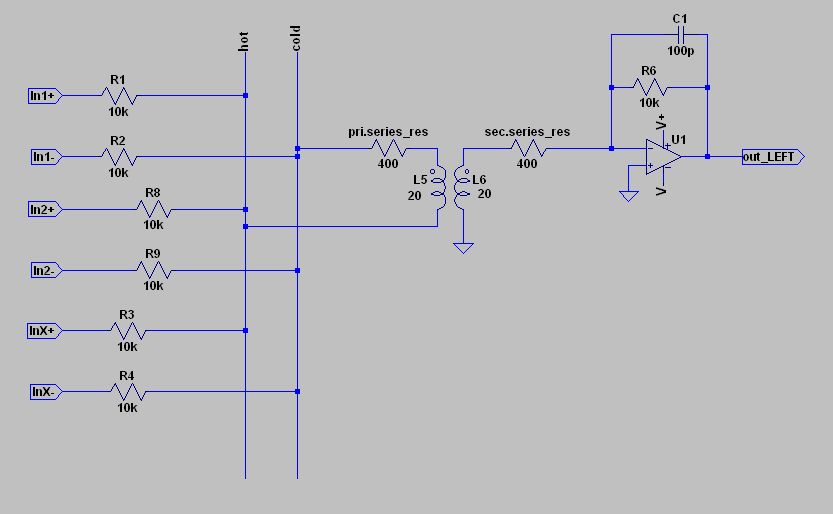I'm currently trying to wrap my head around different methods for analog summing and while doing that, I've found something interesting that I really hope some of you can help me understand 
Basically, it's standard balanced virtual earth summing: There are a bunch of 10k summing resistors on a self-etched PCB with a DB25 input connector. Each channel has two resistors for HOT and COLD connected to their respective bus (HOT left, COLD left, HOT right and COLD right).
But instead of two active stages for each HOT and COLD, there's a transformer that un-balances the signal before going directly to the inverting input of an opamp. See below for a mockup. Note, that there's only one output channel shown. In reality there are two, one for LEFT and one for RIGHT. The transformers and opamps are on solderless breadboard at the moment.

I didn't really expect this to work at all - but it does - and this EXTREMELY well, I might add! ;D
Even on breadboard, the noise is vanishingly low, CMRR is very good and crosstalk between LEFT and RIGHT is less than -90dB at 1kHz. Frequency response is ruler flat up to almost 30kHz (I'm using OEP K30A06C line input transformers). I also expected to see the typical low frequency distortion of a transformer but even that is much better than I thought. Maybe because the voltage across the primary is so low. There are also no hints of instability in the output signal, as seen on the oscilloscope.
My suspicion is that it's merely current that gets transferred to the op-amp as opposed to voltage. That is also suggested by the fact that the output signal gets lower, when the transformer is configured to a voltage step-up of 1:2, which should decrease the current on the secondary. By turning the transformer around for 2:1, the output signal gets louder but at the same time the frequency response starts to decline.
When I did my research, I've never stumbled across this kind of summing stage before and I'm starting to wonder, why this is?! From the measurements I did, it works quite well and there are only two transformers in the whole circuit instead of one for each input channel.
Is there something I'm missing, any obvious or not so obvious drawbacks?
Basically, it's standard balanced virtual earth summing: There are a bunch of 10k summing resistors on a self-etched PCB with a DB25 input connector. Each channel has two resistors for HOT and COLD connected to their respective bus (HOT left, COLD left, HOT right and COLD right).
But instead of two active stages for each HOT and COLD, there's a transformer that un-balances the signal before going directly to the inverting input of an opamp. See below for a mockup. Note, that there's only one output channel shown. In reality there are two, one for LEFT and one for RIGHT. The transformers and opamps are on solderless breadboard at the moment.

I didn't really expect this to work at all - but it does - and this EXTREMELY well, I might add! ;D
Even on breadboard, the noise is vanishingly low, CMRR is very good and crosstalk between LEFT and RIGHT is less than -90dB at 1kHz. Frequency response is ruler flat up to almost 30kHz (I'm using OEP K30A06C line input transformers). I also expected to see the typical low frequency distortion of a transformer but even that is much better than I thought. Maybe because the voltage across the primary is so low. There are also no hints of instability in the output signal, as seen on the oscilloscope.
My suspicion is that it's merely current that gets transferred to the op-amp as opposed to voltage. That is also suggested by the fact that the output signal gets lower, when the transformer is configured to a voltage step-up of 1:2, which should decrease the current on the secondary. By turning the transformer around for 2:1, the output signal gets louder but at the same time the frequency response starts to decline.
When I did my research, I've never stumbled across this kind of summing stage before and I'm starting to wonder, why this is?! From the measurements I did, it works quite well and there are only two transformers in the whole circuit instead of one for each input channel.
Is there something I'm missing, any obvious or not so obvious drawbacks?


